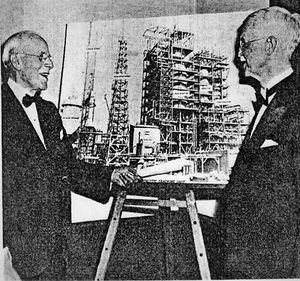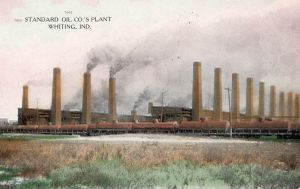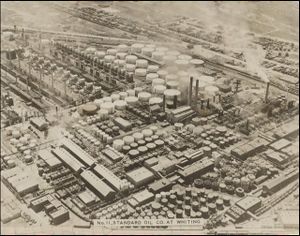Thermal Cracking
The original version of this article was created by Francesco Gerali, 2019 Elizabeth & Emerson Pugh Scholar in Residence at the IEEE History Center
It is recommended this article be cited as:
F. Gerali (2019). Thermal Cracking, Engineering and Technology History Wiki. [Online] Available: https://ethw.org/Thermal_Cracking
Vladimir Grigoryevich Shukhov (1853-1939), together with Sergei Gavrilov, were the Russian physicists and engineers who in 1891 successfully developed a continuous thermal cracking process in Tsarist Russia, after having worked in applied oil field technologies (e.g. pipelining[1] and boilers) for The Petroleum Production Company Nobel Brothers Limited (Branobel) since 1878. The Shukhov Cracking Process was first patented in Russia (no. 12926) on November 27, 1891. The base principle of the process involves the thermal breaking of the heavier hydrocarbon chains under high pressure to obtain lighter and shorter chain fractions.
This was a major advancement in petroleum refining technology. Since the beginning of modern refining in the 1860s, few major advancements in traditional processes were made in more efficient refining of heavier fractions of petroleum. However, the Shukhov process did not find immediate worldwide adoption. The demand for a very light and flammable gasoline-like product was not prevalent, and furthermore, the production on a commercial scale would have required the construction of large, dangerous, and expensive thermal cracking facilities.
This technology and its productive potential came back into the scope of chemical engineering during the early 1900s boom of the young automotive industry. This generated a need for car fuels far beyond what contemporary refining technology could actually produce. This turn towards a high octane gasoline refining market took place at the Standard Oil Company of Indiana facilities of Whiting, Indiana, U.S.A, in 1912.
The chemical engineers William Merriam Burton (1865-1954) and Robert E. Humphreys (1868-1942),[2] began working in this area in 1908. After having persuaded the newly established Indiana’s firm, established from the dissolution of the Standard Oil Company, to invest in the technology, they implemented a well-functioning thermal cracking process similar to the Shukhov Cracking Process. Crude oil was poured into the still and the temperature elevated to the range of 700 to 750 F (371 - 399 C). The flow of petroleum vapors was regulated through a valve system to allow the required pressure, 90 psa equal to 6.2 bar, to be maintained through all the steps of the process. After the fractions had become light and evaporated, these were gathered through the condenser. At the end of the process, the still was opened and the carbon deposits collected. The main yield of this process was gasoline, light gas oil (a diesel-kind fuel oil), residual fuel oil, and petroleum coke.
On January 1913, the Burton-Humphreys thermal cracking process was patented (Patent No. 1,049,667)[3]. The same year, the Whiting refinery, erected in 1893 to produce kerosene for lamps, had already 12 Burton-Humphreys adapted stills in service, which just ten years later reached the number of 900 units in full service. In addition to using thermal cracking to make gasoline for sale, Standard Oil of Indiana also earned great profits in royalties, some $15 million between 1913 and 1930, by giving the patent in license to other refining companies. Soon, the method was used throughout the petroleum industry all over the world.
At the same time, the Burton-Humphreys patent was accused of infringement by Shukhov of his 1891 patent. The quarrel was resolved in favor of the Standard Oil Company of Indiana, but in Russia the Shukhov process was used without acknowledging the rights to the Indiana company. Various improvements to thermal cracking were introduced into the 1920s, until it was surpassed by the most effective (to yield higher octane gasoline) catalytic cracking process in 1937.
Today the original Burton-Humphreys process is no longer in use, with an exception for some diesel-kind fuels. However, many of the current refining processes owe much to the thermal cracking idea pioneered by Vladimir Grigoryevich Shukhov in the 19th century, and the 20th century successful development and results obtained by the two American chemists, from the relevant technological investments made by their company.
References
Burton William M. Manufacture of Gasolene. United States. Patent no. US1049667A. Assignee Standard Oil Company.
Black, Brian. Crude reality: petroleum in world history. Lanham Md.: Rowman & Littlefield Publishers, 2012.
Cobb, Cathy, and Harold Goldwhite. Creations of fire: chemistry's lively history from alchemy to the atomic age. Cambridge, Mass: Perseus Pub., 2001.
(The) Federal State Budget Educational Institution of Higher Education Belgorod State Technological University named after V.G. Shukhov http://en.bstu.ru/about/acquaintance/shukhov_vladimir_grigorievichv
Larson, Henrietta M., and Kenneth Wiggins Porter. History of Humble Oil & Refining Company; a study in industrial growth. New York: Harper, 1959.
Copp, Newton, and Andrew Zanella. Discovery, innovation, and risk: case studies in science and technology. Cambridge, Mass: MIT Press, 1993.
Vassiliou, M. S. Historical dictionary of the petroleum industry. Lanham, Md: Scarecrow Press, 2009.



